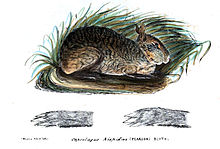The hispid hare (Caprolagus hispidus), also called Assam rabbit and bristly rabbit, is a leporid native to South Asia, whose historic range extended along the southern foothills of the Himalayas. Today, its habitat is highly fragmented with an area of occupancy estimated at less than 500 km2 (190 sq mi) extending over an area of 5,000 to 20,000 km2 (1,900 to 7,700 sq mi). Populations experienced a continuing decline in suitable habitat due to increasing agriculture, flood control, and human development. It is therefore listed as Endangered on the IUCN Red List since 1986.[1] It is the only species in the genus Caprolagus.
| Hispid hare | |
|---|---|

| |
| Scientific classification | |
| Domain: | Eukaryota |
| Kingdom: | Animalia |
| Phylum: | Chordata |
| Class: | Mammalia |
| Order: | Lagomorpha |
| Family: | Leporidae |
| Genus: | Caprolagus Blyth, 1845 |
| Species: | C. hispidus
|
| Binomial name | |
| Caprolagus hispidus (Pearson, 1839)
| |

| |
| Hispid hare range | |
Characteristics
editThe hispid hare has a harsh and bristly coat. Its ears are very short and do not project beyond the fur.[2] The coat is dark brown on the back due to a mixture of black and brown hairs; brown on the chest and whitish on the abdomen. The tail is brown and about 30 mm (1.2 in) long. In body weight males range from 1,810 to 2,610 g (64 to 92 oz) with a mean of 2,248 g (79.3 oz). Females weigh on average 2,518 g (88.8 oz); a heavily pregnant female weighing 3,210 g (113 oz) was included in this statistical mean weight.[3]
The frontal bones are very wide. The occipito-nasal length generally exceeds 85 mm (3.3 in). There is no clear notch in front of postorbital processes.[4]
In average, this hare is 476 mm (18.7 in) long from head to tail.[5]
Distribution and habitat
editThe historical range of the hispid hare extended from Uttar Pradesh through southern Nepal, the northern region of West Bengal to Assam and into Bangladesh. Today, its distribution is sporadic in Bangladesh, India, Nepal and Bhutan. It inhabits tracts of early successional tall grasslands and takes refuge in marshy areas or grasses adjacent to river banks during the dry season, when these areas are susceptible to burning.[3] The population in the extensive grasslands of Shuklaphanta National Park may be of international significance.[6]
In January 2016, a hispid hare was recorded in Chitwan National Park for the first time since 1984.[7]
Ecology
editThe hispid hare is most active at dawn and dusk. The limited information available on reproduction indicates that its average litter size is small.[3]
Threats
editGrassland habitats of the hispid hare are threatened due to overgrazing by cattle.[8]
References
edit- ^ a b c Aryal, A.; Yadav, B. (2019). "Caprolagus hispidus". IUCN Red List of Threatened Species. 2019: e.T3833A45176688. doi:10.2305/IUCN.UK.2019-1.RLTS.T3833A45176688.en. Retrieved 16 January 2022.
- ^ Pearson, J. T. (1839). "18. Lepus hispidus". Proceedings of the Zoological Society of London. VII: 152.
- ^ a b c Bell, D. J.; Oliver, W. L. R.; Ghose, R. K. (1990). "Chapter 9: The Hispid Hare Caprolagus Hispidus". In Chapman, J. A.; Flux, J. E. C. (eds.). Rabbits, Hares, and Pikas: Status Survey and Conservation Action Plan. Gland, Switzerland: International Union for Conservation of Nature and Natural Resources. pp. 128–137. ISBN 978-2831700199.
- ^ Ellerman, J. R.; Morrison-Scott, T. C. S. (1966). Checklist of Palaearctic and Indian mammals 1758 to 1946 (2nd ed.). London: British Museum of Natural History. p. 424.
- ^ Macdonald, D. W. (2009). The Encyclopedia of Mammals. Oxford University Press. ISBN 978-0-19-956799-7.
- ^ Baral, H.S.; Inskipp, C. (2009). "The Birds of Sukla Phanta Wildlife Reserve, Nepal". Our Nature. 7: 56–81. doi:10.3126/on.v7i1.2554.
- ^ Khadka, B.B.; Yadav, B.P.; Aryal, N. & Aryal, A. (2017). "Rediscovery of the hispid hare (Caprolagus hispidus) in Chitwan National Park, Nepal after three decades". Conservation Science. 5 (1): 10–12. doi:10.3126/cs.v5i1.18560.
- ^ Maheswaran, G. (2013). "Ecology and Conservation of Endangered Hispid Hare Caprolagus hispidus in India". In Singaravelan, N. (ed.). Rare Animals of India. Bentham Science Publishers. pp. 179–203. doi:10.2174/9781608054855113010012.
